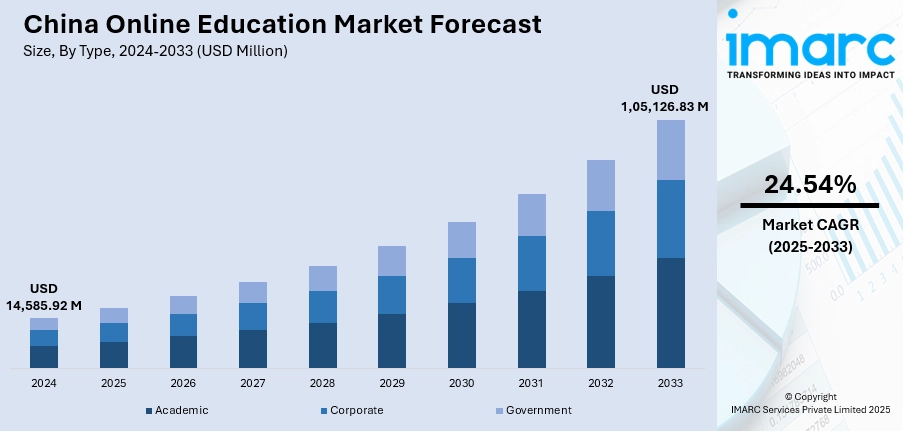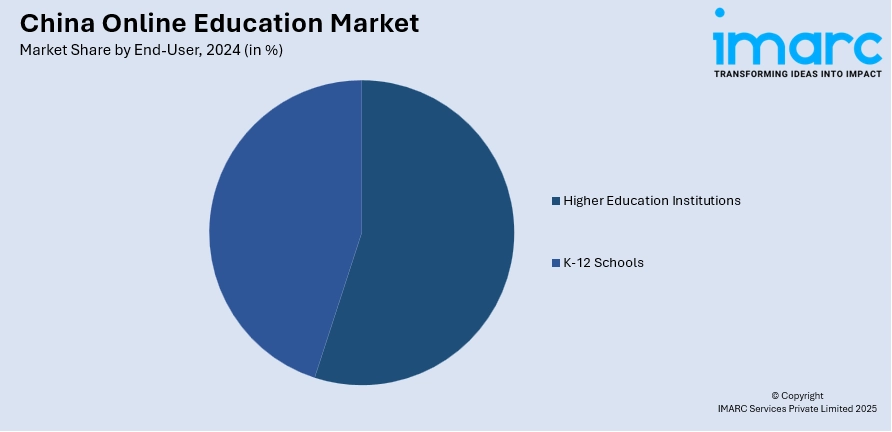
China Online Education Market Size, Share, Trends and Forecast by Type, Provider, Technology, End-User, and Region, 2025-2033
China Online Education Market Overview:
The China online education market size reached USD 14,585.92 Million in 2024. The market is projected to reach USD 1,05,126.83 Million by 2033, exhibiting a growth rate (CAGR) of 24.54% during 2025-2033. The market is fueled by the growing uptake of digital technologies and internet penetration throughout the nation, which has enabled online learning accessible to a greater number of people. In addition, government programs and policies for digital learning equipment and content creation have driven market expansion. Further, the growing need for flexible study options, particularly among working individuals and pupils in rural regions, is further expanding the China online education market share.
|
Report Attribute
|
Key Statistics
|
|---|---|
|
Base Year
|
2024
|
|
Forecast Years
|
2025-2033
|
|
Historical Years
|
2019-2024
|
| Market Size in 2024 | USD 14,585.92 Million |
| Market Forecast in 2033 | USD 1,05,126.83 Million |
| Market Growth Rate 2025-2033 | 24.54% |
China Online Education Market Trends:
Integration of AI and Adaptive Learning Technologies
Artificial intelligence is increasingly shaping the structure and delivery of online education in China, enhancing personalization, efficiency, and learner engagement. According to an industry report published on April 17, 2025, China plans to integrate artificial intelligence (AI) into its education system, targeting primary, secondary, and higher education levels. This initiative aims to foster innovation and enhance essential skills such as independent thinking, problem-solving, communication, and cooperation. The move follows the launch of AI courses at Chinese universities and the introduction of a competitive, cost-effective large-language model by DeepSeek in January 2025. Additionally, China's national action plan, unveiled in January, seeks to establish the country as a "strong-education nation" by 2035, focusing on leveraging innovation to achieve this goal. Advanced AI-driven algorithms are used to assess student performance in real time, customize learning paths, and offer instant feedback. Online educational platforms have incorporated adaptive learning engines that dynamically adjust content difficulty based on a learner's progress and cognitive behavior. This ensures that students remain challenged but not overwhelmed, ultimately leading to improved academic outcomes. AI also enables features like smart tutoring systems, automated grading, and predictive analytics that identify students at risk of falling behind. Additionally, generative AI tools are employed to create tailored content such as quizzes, simulations, and video explanations, reducing production time and improving instructional design. These innovations are increasingly supported by significant investments in AI research and infrastructure, underscoring the strategic role of intelligent technologies in shaping the future of digital education across the country.

To get more information on this market, Request Sample
Expansion of Hybrid Education Models
The hybrid learning models that combine online content delivery with offline tutoring or school-based instruction are facilitating the China online education market growth. This shift is driven by policy adjustments encouraging regulated, holistic learning environments. China has made remarkable progress in adapting digital learning technologies throughout its education system. The national-scale platform "Smart Education of China" (SEC), which was launched in early 2022, exemplifies the country's rapid adoption and expansion of digital learning infrastructure. By the end of 2023, the platform had linked 519,000 educational institutions, serving 18.8 million teachers and 293 million learners, indicating an extensive penetration into primary, secondary, vocational, and higher education sectors. Moreover, edtech companies are partnering with brick-and-mortar schools, community centers, and private tutoring centers to offer blended programs that integrate digital tools with face-to-face support. Such models cater to the preferences of parents and educators who value human interaction while leveraging the scalability and convenience of online platforms. Moreover, hybrid models allow for diversified revenue streams and enhanced brand credibility in a tightly regulated market. The model is also gaining traction in rural and second-tier cities, where it helps bridge the education gap through resource-sharing between online systems and local institutions.
China Online Education Market Segmentation:
IMARC Group provides an analysis of the key trends in each segment of the market, along with forecasts at the country and regional levels for 2025-2033. Our report has categorized the market based on type, provider, technology, and end-user.
Type Insights:
- Academic
- Higher Education
- Vocational Training
- K-12 Education
- Corporate
- Large Enterprises
- SMBs
- Government
The report has provided a detailed breakup and analysis of the market based on the type. This includes academic (higher education, vocational training, and k-12 education), corporate (large enterprises and SMBs), and government.
Provider Insights:
- Content
- Services
A detailed breakup and analysis of the market based on the provider have also been provided in the report. This includes content and services.
Technology Insights:
- Mobile E-Learning
- Rapid E-Learning
- Virtual Classroom
- Others
The report has provided a detailed breakup and analysis of the market based on the technology. This includes mobile E-learning, rapid E-learning, virtual classroom, and others.
End-User Insights:

- Higher Education Institutions
- K-12 Schools
A detailed breakup and analysis of the market based on the end-user have also been provided in the report. This includes higher education institutions and k-12 schools.
Regional Insights:
- North China
- East China
- South Central China
- Southwest China
- Northwest China
- Northeast China
The report has also provided a comprehensive analysis of all the major regional markets, which include North China, East China, South Central China, Southwest China, Northwest China, and Northeast China.
Competitive Landscape:
The market research report has also provided a comprehensive analysis of the competitive landscape. Competitive analysis such as market structure, key player positioning, top winning strategies, competitive dashboard, and company evaluation quadrant has been covered in the report. Also, detailed profiles of all major companies have been provided.
China Online Education Market News:
- On March 18, 2025, DBIC Online launched the "HR Management in China Certificate Program" to offer an in-depth insight of human resource management in the market. The program consists of four online courses, combining academic faculty and industry experts, and includes case studies on Chinese enterprises' global expansion. Upon completing the coursework and exams, participants will receive a certificate from Shanghai Jiao Tong University.
- On June 8, 2025, Xueersi, a Chinese online education platform, introduced an upgraded AI programming curriculum to foster a new generation of tech-savvy students, aligning with China's push to integrate artificial intelligence into education. The revamped curriculum incorporates new tools, teaching methods, content, and learning formats, highlighted by the Aladdin platform, which enables students to build applications using natural language. This move follows Beijing's initiative to incorporate AI education into the national curriculum, with support from experts like Stanford's James Landay.
China Online Education Market Report Coverage:
| Report Features | Details |
|---|---|
| Base Year of the Analysis | 2024 |
| Historical Period | 2019-2024 |
| Forecast Period | 2025-2033 |
| Units | Million USD |
| Scope of the Report |
Exploration of Historical Trends and Market Outlook, Industry Catalysts and Challenges, Segment-Wise Historical and Future Market Assessment:
|
| Types Covered |
|
| Providers Covered | Content, Services |
| Technologies Covered | Mobile E-Learning, Rapid E-Learning, Virtual Classroom, Others |
| End-Users Covered | Higher Education Institutions, K-12 Schools |
| Regions Covered | North China, East China, South Central China, Southwest China, Northwest China, Northeast China |
| Customization Scope | 10% Free Customization |
| Post-Sale Analyst Support | 10-12 Weeks |
| Delivery Format | PDF and Excel through Email (We can also provide the editable version of the report in PPT/Word format on special request) |
Key Questions Answered in This Report:
- How has the China online education market performed so far and how will it perform in the coming years?
- What is the breakup of the China online education market on the basis of type?
- What is the breakup of the China online education market on the basis of provider?
- What is the breakup of the China online education market on the basis of technology?
- What is the breakup of the China online education market on the basis of end-user?
- What is the breakup of the China online education market on the basis of region?
- What are the various stages in the value chain of the China online education market?
- What are the key driving factors and challenges in the China online education market?
- What is the structure of the China online education market and who are the key players?
- What is the degree of competition in the China online education market?
Key Benefits for Stakeholders:
- IMARC’s industry report offers a comprehensive quantitative analysis of various market segments, historical and current market trends, market forecasts, and dynamics of the China online education market from 2019-2033.
- The research report provides the latest information on the market drivers, challenges, and opportunities in the China online education market.
- Porter's five forces analysis assist stakeholders in assessing the impact of new entrants, competitive rivalry, supplier power, buyer power, and the threat of substitution. It helps stakeholders to analyze the level of competition within the China online education industry and its attractiveness.
- Competitive landscape allows stakeholders to understand their competitive environment and provides an insight into the current positions of key players in the market.
Need more help?
- Speak to our experienced analysts for insights on the current market scenarios.
- Include additional segments and countries to customize the report as per your requirement.
- Gain an unparalleled competitive advantage in your domain by understanding how to utilize the report and positively impacting your operations and revenue.
- For further assistance, please connect with our analysts.
 Request Customization
Request Customization
 Speak to an Analyst
Speak to an Analyst
 Request Brochure
Request Brochure
 Inquire Before Buying
Inquire Before Buying




.webp)




.webp)












